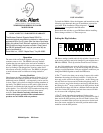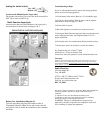
Setting the Audio Switch:
Top - OFF
Bottom - ON
Located on the DB100 Signaler (larger unit):
The speaker switch allows you to turn the Audio Alarm ON or
OFF. ON is down and OFF is up.
Multi-Function Input Jack:
Located on the right side of the DB Sensor, this input jack is
for installations as shown below in diagram 2 & 3.
DB100 INSTALLATION DIAGRAMS
Battery free installation (diagram 3):
Use wire provided, plug into jack outlet on side of
Transmitter. Remove chime cover and connect the red
and yellow wires to chime box terminal screws common
and front.
Troubleshooting & Help:
If you’ve followed the directions and are still having problems
please try the following suggestions:
1) Check battery in the sensor. Must be a 12-volt alkaline type.
2) Check dip switch settings. Both the sensor and the signaler
must match as shown in figure 1.1 above.
3) Check outlet for power.
4) Move the Signaler to an outlet closer to the sensor unit.
5) If using the Multi-Function input jack make sure that the wires
are not touching each other. See diagram number 2 & 3 for
proper installation.
6) Check that sensor is not further than 50 feet from the receiver.
7) Do not place sensor on steel doors or steel door frames.
For Technical help call 1-248-577-5400
M-F 8:00 a.m. – 5:00 p.m. Eastern Time
Or e-mail us with your questions at sonic-info@sonicalert.com
Warranty:
Thank you for purchasing this high quality Sonic Alert product. We hope you
will have many years of satisfied use. This Sonic Alert product comes with a
limited 5-year warranty so please retain your receipt in a safe place for possible
future reference; you will need in the event of warranty service.
Sonic Alert, Inc.
1050 East Maple Rd.
Troy, MI 48083
V/TTY 1-248-577-5400 fax 248-577-5433
E-mail: sonic-info@sonicalert.com
Web Site: www.SonicAlert.com
REV 1.5 (2008)
This device complies with Part 15 of the FCC Rules and with RSS-210
of Industry Canada. Operation is subject to the following two
conditions:
(1) This device may not cause harmful interference, and
(2) This device must accept any interference received, including
interference that may cause undesired operation.
WARNING: Changes or modifications not expressively
approved by the party responsible for compliance could void
user’s authority to operate the equipment.




